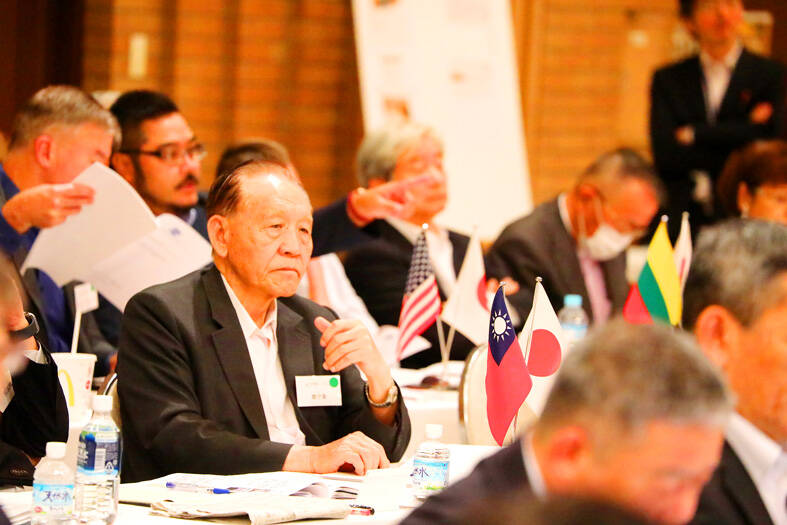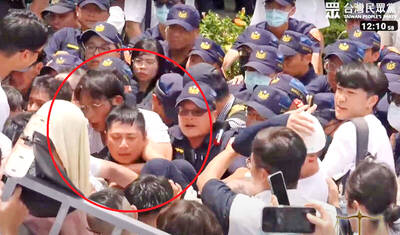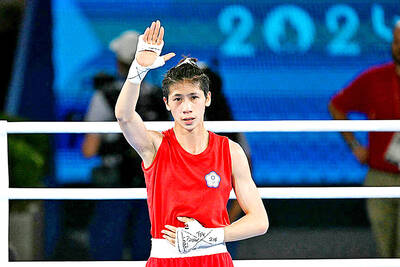A tabletop exercise conducted by a Japanese think tank simulating a Chinese invasion of Taiwan ended with the Chinese People’s Liberation Army (PLA) being cut off from logistics at sea and a deadlock on land, before the UN mediated an armistice.
The Japan Forum for Strategic Studies hosted the exercise in Tokyo on Saturday and Sunday in collaboration with military officials and analysts from Taiwan, the US and Japan. It was the third such simulation the think tank had conducted this year.
Taiwan’s participation in the exercise was a first.

Photo: CNA
The exercise simulated the PLA attacking the area from New Taipei City’s Bali District (八里) to Hsinchu’s Nanliao (南寮), said Su Tzu-yun (蘇紫雲), director of defense strategy and resources at the Institute for National Defense and Security Research (INDSR).
The tabletop scenario was similar to the field exercise portion of this year’s annual Han Kuang military exercises, which are to be held from Monday to Sunday next week, Su said.
The outcome was considered a victory for the Taiwanese, US and Japanese defenders, as the PLA was “effectively stopped from pushing into the interior” of Taiwan proper, he said.
The three countries’ representatives took note that a politically significant settlement could only be reached if the PLA’s forces on Taiwan proper were completely expelled or eliminated, Su said.
The simulation had three distinct phases: China’s initial efforts to isolate Taiwan, Japan providing Taiwan with logistical and humanitarian aid, and Beijing ordering the invasion of Taiwan and missile attacks on Japan, he said.
The first phase of the exercise had China launching a disinformation campaign against Taiwan and Japan, cutting the Internet cables to Taiwan proper and Okinawa, and landing Chinese fishers on the Diaoyutai Islands (釣魚台), known as the Senkakus in Japan, he said.
In the second phase, Tokyo agreed to offer logistical support and humanitarian aid to Taiwan at the US’ request, Su said.
The third phase simulated PLA offensive operations aimed at taking over Taiwan proper and its outlying islands, and included missile strikes on bases used by the US military and the Japanese Self-Defense Forces, he said.
Taiwan’s armed forces stopped the PLA from entering the main island’s interior, while joint US-Japan undersurface operations crippled the PLA’s ability to acquire reinforcements and supplies from sea, the INDSR said.
As fighting in the areas around Taiwan shifted in favor of the defenders, the UN and the International Committee of the Red Cross intervened to mediate a ceasefire, the institute said.
The exercise was part of the bilateral security dialogue between Taiwan and Japan, it said.
Japanese Representative and former defense minister Itsunori Onodera, several retired Japanese Self-Defense Forces officers, INDSR chairman Huoh Shoou-yeh (霍守業), INDSR deputy CEO Lee Ting-sheng (李廷盛) and Su played a role in the simulation, it said.

FIREPOWER: On top of the torpedoes, the military would procure Kestrel II anti-tank weapons systems to replace aging license-produced M72 LAW launchers Taiwan is to receive US-made Mark 48 torpedoes and training simulators over the next three years, following delays that hampered the navy’s operational readiness, the Ministry of National Defense’s latest budget proposal showed. The navy next year would acquire four training simulator systems for the torpedoes and take receipt of 14 torpedoes in 2027 and 10 torpedoes in 2028, the ministry said in its budget for the next fiscal year. The torpedoes would almost certainly be utilized in the navy’s two upgraded Chien Lung-class submarines and the indigenously developed Hai Kun, should the attack sub successfully reach operational status. US President Donald Trump

TPP RALLY: The clashes occurred near the Chiang Kai-shek Memorial Hall on Saturday at a rally to mark the anniversary of a raid on former TPP chairman Ko Wen-je People who clashed with police at a Taiwan People’s Party (TPP) rally in Taipei on Saturday would be referred to prosecutors for investigation, said the Ministry of the Interior, which oversees the National Police Agency. Taipei police had collected evidence of obstruction of public officials and coercion by “disorderly” demonstrators, as well as contraventions of the Assembly and Parade Act (集會遊行法), the ministry said in a statement on Sunday. It added that amid the “severe pushing and jostling” by some demonstrators, eight police officers were injured, including one who was sent to hospital after losing consciousness, allegedly due to heat stroke. The Taipei

NO LIVERPOOL TRIP: Taiwan’s Lin Yu-ting, who won a gold medal in the boxing at the Paris Olympics, was embroiled in controversy about her gender at that event Taiwanese boxer Lin Yu-ting (林郁婷) will not attend this year’s World Boxing Championships in Liverpool, England, due to a lack of response regarding her sex tests from the organizer, World Boxing. The national boxing association on Monday said that it had submitted all required tests to World Boxing, but had not received a response as of Monday, the departure day for the championships. It said the decision for Lin to skip the championships was made to protect its athletes, ensuring they would not travel to the UK without a guarantee of participation. Lin, who won a gold medal in the women’s 57kg boxing

The US has revoked Taiwan Semiconductor Manufacturing Co’s (TSMC, 台積電) authorization to freely ship essential gear to its main Chinese chipmaking base, potentially curtailing its production capabilities at that older-generation facility. American officials recently informed TSMC of their decision to end the Taiwanese chipmaker’s so-called validated end user (VEU) status for its Nanjing site. The action mirrors steps the US took to revoke VEU designations for China facilities owned by Samsung Electronics Co and SK Hynix Inc. The waivers are set to expire in about four months. “TSMC has received notification from the US Government that our VEU authorization for TSMC Nanjing